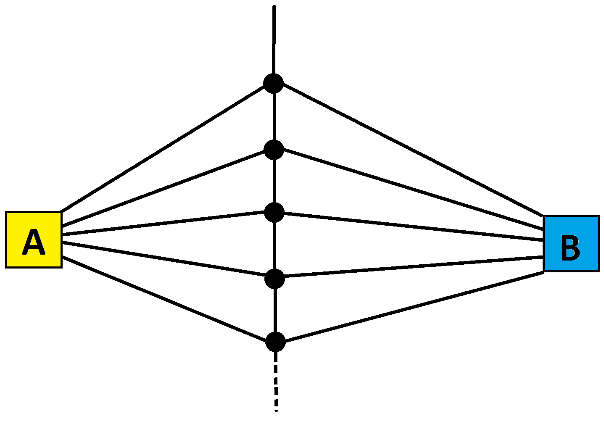The Astounding Power of Area
4.4 The Geometric Series Formula
Let’s have some fun with garden paths.
Imagine a garden path with infinitely many forks that split into three parts as shown. Those that turn left at a fork go to house A, those that turn right to house B, and those who go straight continue to the next fork.

This leads to the area picture:

The probability of ending up in house A is:
\(\dfrac{1}{3}+\dfrac{1}{9}+\dfrac{1}{27}+\dfrac{1}{81}+ \ldots\),
as are the chances of ending up in house B.
But do you see that half the square is devoted to house A and half to house B? It follows then that we must have:
\(\dfrac{1}{3}+\dfrac{1}{9}+\dfrac{1}{27}+\dfrac{1}{81}+ \ldots=\dfrac{1}{2}\).
CHALLENGE: Use garden paths to establish that
\(\dfrac{1}{N}+\dfrac{1}{N^{2}}+\dfrac{1}{N^{3}}+ \ldots = \dfrac{1}{N-1}\)
for any positive integer \(N > 1\).
Can you prove the general geometric series formula \(x+x^{2}+x^{3}+\ldots = \dfrac{x}{1-x}\) for \(0<x<1\) using garden paths?
EXTRA: See Lesson 4.7 as we push this example further and show how it opens the gateway to a host of infinite probability processes!
Resources
Books
Take your understanding to the next level with easy to understand books by James Tanton.
BROWSE BOOKS![]()
Guides & Solutions
Dive deeper into key topics through detailed, easy to follow guides and solution sets.
BROWSE GUIDES![]()
Donations
Consider supporting G'Day Math! with a donation, of any amount.
Your support is so much appreciated and enables the continued creation of great course content. Thanks!
Ready to Help?
Donations can be made via PayPal and major credit cards. A PayPal account is not required. Many thanks!
DONATE![]()


